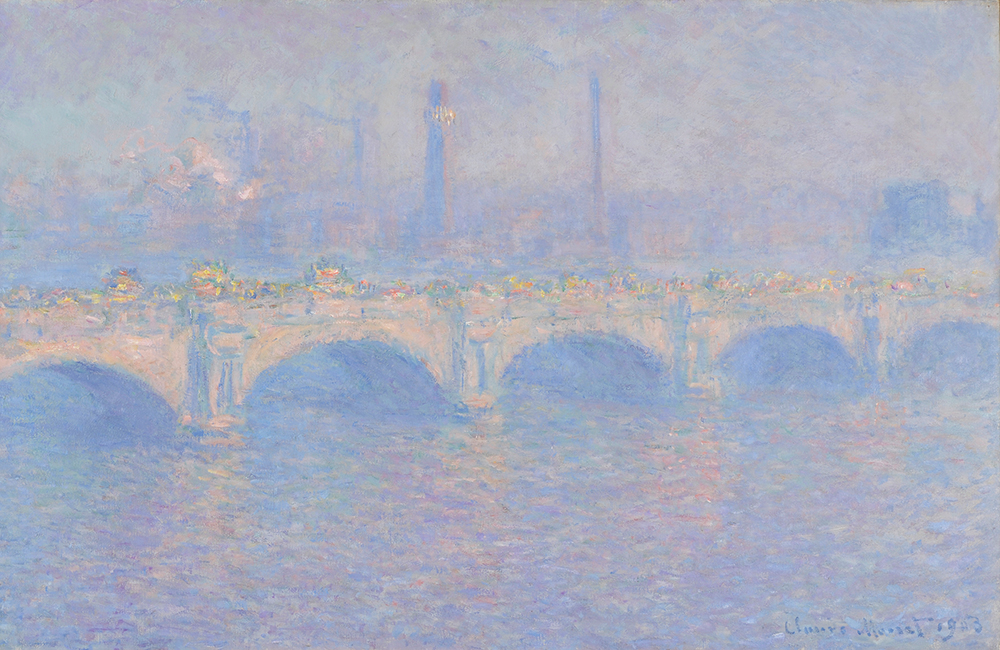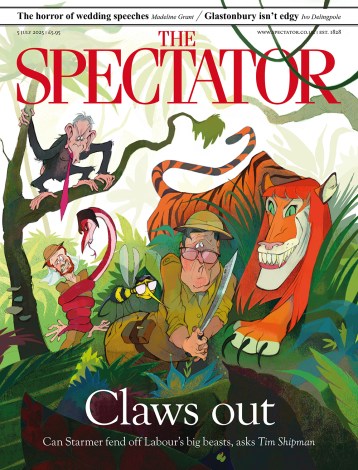For the maids on the top floors of the Savoy, everything was in turmoil. The 6th had been commandeered by wounded Boer War officers, and since February 1900 a suite of rooms on the 5th had been taken over by a French painter, who was using one as a studio. The officers were nice enough, but the Frenchman spoke almost no English and you could smell the turps down the corridor. Whatever was the management thinking?
‘Without the fog, London wouldn’t be a beautiful city. It’s the fog that gives it its magnificent breadth’
What the management was thinking was that the Frenchman was an internationally famous artist and the Thames views that he was painting from his window would serve as great publicity for the capital’s most expensive hotel, which in 1900 advertised ‘a panorama from Battersea to the Tower Bridge… in all weathers, in sunshine or in rain or in the fog loved by Mr Whistler, a thing of beauty’.
It was Monet’s second stay at the Savoy – the previous autumn of 1899 he had shared a 6th floor suite with his wife Alice and stepdaughter Germaine – and his fourth in London. During the Franco-Prussian war 30 years earlier he had spent ‘a miserable time’ cooped up in a poky flat off Piccadilly Circus with first wife Camille and their young son Jean, dodging the draft. Now he was back, a wealthy artist about to turn 60, embarking on his most ambitious painting project. If Monet hadn’t already started working in series, the vagaries of the British climate would have forced him to. When the weather wouldn’t co-operate at his home in Giverny he would go back to bed and sulk, but that was not an option at the Savoy. So he developed a system of shifting between canvases, starting a new one to capture a new effect, then picking up an old when an effect was repeated. It wasn’t foolproof: in the rush he sometimes noticed too late ‘that I had overlooked the very one that would have suited me best and that was right under my nose’.
His initial focus was on the views from his Savoy balcony looking east towards Waterloo Bridge and west towards the new railway bridge serving Charing Cross station. Like other impressionists, Monet was a recorder of modern life and there was no more modern city in Europe than London. Unlike Paris, where industry was confined to the suburbs, in London you had only to look across from the Savoy to the South Bank to see an array of chimneys belching smoke.
What attracted Monet was not the smokestacks so much as the smoke and the ‘delicious fog’ it conjured when mixed with steam from train locomotives and barges and vapour rising from river. ‘I so love London!’ he declared years later, ‘but I only love London in the winter… without the fog London wouldn’t be a beautiful city. It’s the fog that gives it its magnificent breadth.’
Like Turner, Monet was more interested in the ‘envelope’ of air wrapping a landmark than the landmark itself, and the envelope of London fog presented a unique chromatic challenge. As he explained on his third visit in 1901: ‘The fog assumes all sorts of colours; there are black, brown, yellow, green, purple fogs, and the interest in painting is to get the objects as seen through all these fogs.’ On the rare occasions when the sun shone with a ‘horrendous clarity’, he cursed; he particularly dreaded ‘the damned English Sunday’ when the smoking chimneys had a day of rest.
From his second visit, he expanded his repertoire to include the Houses of Parliament viewed against the setting sun from a covered terrace at the new St Thomas’ Hospital. The canvases piled up: by the end he had accumulated nearly 100, most of them, by his own admission, ‘only experiments, explorations, preparations’. Taking them back to Giverny to work on, he had to rely on recollection and – especially with the Houses of Parliament, painted at dusk – the fog of memory thickened the envelope. With the bridges, painted in the mornings from the comfort of his balcony, he had been able to spend more time in front of the motif. In ‘Waterloo Bridge, Overcast Weather’ (1900) the topography of the South Bank is clear to see, with a traffic jam of double-deckers crawling over the bridge – in Monet’s London it seems to be permanent rush hour. By comparison there is curiously little traffic on the river, then the city’s main artery. Perhaps he was too busy chasing weather effects to bother with boats; besides, too much detail would have spoiled the impression of breadth.
Monet was a keen Anglophile –a fan of tweed, tea, a full English and Yorkshire puddings
At a Paris exhibition of 37 of Monet’s Thames views in 1904, the dealer Paul Durand-Ruel priced the Houses of Parliament highest – 20,000 FR compared with 15,000 FR for the bridges – but of the 21 canvases in the Courtauld’s show, I liked them least. Painted at dusk when the light was fading almost too fast to catch, they don’t give you the jolt of recognition you get from a faithfully observed lighting effect. As he became more acclimatised to the London weather, Monet reported feeling ‘able to apply big slashing brushstrokes to canvases that… were more or less finished but didn’t look Londoniennes enough’. You can see these slashing strokes in the show’s poster image of ‘The Houses of Parliament’ (1904) and they look formulaic: there’s none of that dance between the brush and the motif that brings a paint surface alive.
The reason fogs are a natural complement to the bridges carrying buses and trains full of workers through the world’s most populous city is because both are manifestations of modern life. Even when shrouded in mist the bridges feel anchored in reality, but the mock-historic Houses of Parliament – finished just 30 years earlier – look like they might float away. Wrapped around their faux-gothic silhouettes at dusk the fog suggests a scene from a Hammer Horror. Is that a sail dimly discernible through the haze in ‘The Houses of Parliament. Effect of Fog. London’ (1904) or a caped Christopher Lee? Monet rejected Turner’s ‘exuberant romanticism’, but with his sunsets setting the Thames ablaze his Houses of Parliament are romantic without the exuberance. From the very same spot 70 years earlier, Turner had painted the old Palace of Westminster actually on fire.

In Paris, though, Monet’s tourist views of London flew off the walls of Durand-Ruel’s gallery. The painter Paul-Albert Besnard hailed ‘the prodigious views of the Thames by our French Turner’ – a compliment the Frenchman will have greeted with a Gallic shrug. Yet Monet was a keen Anglophile – a fan of tweed, tea, a full English and Yorkshire puddings (he got the recipe from the Savoy Grill, but it never tasted as good in France) – and he longed to repeat his Parisian success in London. The problem was that with 24 pictures gone to international collectors, they needed to be replaced with new ones. He returned to working up unfinished canvases, but the task was beyond him; in March 1905, three weeks before the show was due to open, he bottled it.
Who needs a French Turner when you have the original?
Would a London show have been a success? Possibly not. Who needs a French Turner when you have the original? British critics of the Paris exhibition didn’t find Monet’s fogs sufficiently ‘Londoniennes’: a reviewer from the Burlington Magazine claimed not to recognise the distinctive ‘light and colour’ of foggy London, while granting that ‘the almost morbid charm of the light in London is perhaps impossible to catch’. But it was the Manchester impressionist Wynford Dewhurst who put his finger on Monet’s basic problem, that the fogs ‘are to the foreigner London’s greatest charm, although to the inhabitant they are a deadly infliction’.
Now that peasoupers are history, we can view them through a fog of nostalgia. Some 120 years on from Monet’s cancelled London show, the Courtauld’s is bound to be a huge success.







Comments